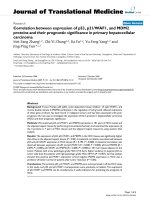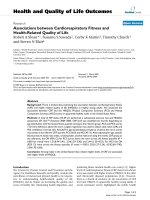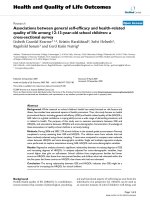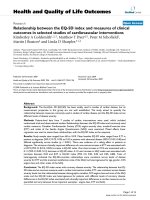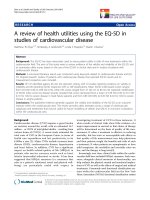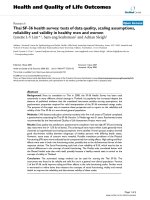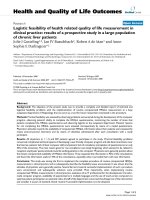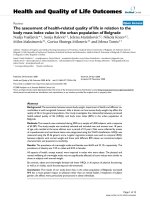báo cáo hóa học:" Correspondence between EQ-5D health state classifications and EQ VAS scores" potx
Bạn đang xem bản rút gọn của tài liệu. Xem và tải ngay bản đầy đủ của tài liệu tại đây (236.97 KB, 9 trang )
BioMed Central
Page 1 of 9
(page number not for citation purposes)
Health and Quality of Life Outcomes
Open Access
Research
Correspondence between EQ-5D health state classifications and
EQ VAS scores
David K Whynes* for the TOMBOLA Group
Address: School of Economics, University of Nottingham, Nottingham NG7 2RD, UK
Email: David K Whynes* -
* Corresponding author
Abstract
Background: The EQ-5D health-related quality of life instrument comprises a health state
classification followed by a health evaluation using a visual analogue scale (VAS). The EQ-5D has
been employed frequently in economic evaluations, yet the relationship between the two parts of
the instrument remains ill-understood. In this paper, we examine the correspondence between
VAS scores and health state classifications for a large sample, and identify variables which
contribute to determining the VAS scores independently of the health states as classified.
Methods: A UK trial of management of low-grade abnormalities detected on screening for cervical
pre-cancer (TOMBOLA) provided EQ-5D data for over 3,000 women. Information on distress and
multi-dimensional health locus of control had been collected using other instruments. A linear
regression model was fitted, with VAS score as the dependent variable. Independent variables
comprised EQ-5D health state classifications, distress, locus of control, and socio-demographic
characteristics. Equivalent EQ-5D and distress data, collected at twelve months, were available for
over 2,000 of the women, enabling us to predict changes in VAS score over time from changes in
EQ-5D classification and distress.
Results: In addition to EQ-5D health state classification, VAS score was influenced by the subject's
perceived locus of control, and by her age, educational attainment, ethnic origin and smoking
behaviour. Although the EQ-5D classification includes a distress dimension, the independent
measure of distress was an additional determinant of VAS score. Changes in VAS score over time
were explained by changes in both EQ-5D severities and distress. Women allocated to the
experimental management arm of the trial reported an increase in VAS score, independently of any
changes in health state and distress.
Conclusion: In this sample, EQ VAS scores were predictable from the EQ-5D health state
classification, although there also existed other group variables which contributed systematically
and independently towards determining such scores. These variables comprised psychological
disposition, socio-demographic factors such as age and education, clinically-important distress, and
the clinical intervention itself.
Trial registration: ISRCTN34841617
Published: 7 November 2008
Health and Quality of Life Outcomes 2008, 6:94 doi:10.1186/1477-7525-6-94
Received: 24 July 2008
Accepted: 7 November 2008
This article is available from: />© 2008 Whynes and the TOMBOLA Group; licensee BioMed Central Ltd.
This is an Open Access article distributed under the terms of the Creative Commons Attribution License ( />),
which permits unrestricted use, distribution, and reproduction in any medium, provided the original work is properly cited.
Health and Quality of Life Outcomes 2008, 6:94 />Page 2 of 9
(page number not for citation purposes)
Background
The EQ-5D is a well-established and widely-used generic
instrument for assessing health-related quality of life [1].
Designed as a self-completion questionnaire, it embodies
two components, a health state description followed by
an evaluation. The respondent classifies his or her prevail-
ing state of health by selecting one of three different levels
of problem severity within each of five health domains.
The levels are none, moderate and severe/extreme (coded
1 through 3, respectively), whilst the domains are mobil-
ity, capacity for self-care, conduct of usual activities, pain/
discomfort and anxiety/depression, ordered as such. The
conscious health states are therefore limited to 243 sever-
ity/domain vectors, ranging from 11111 (no problems in
any domain) to 33333 (severe problems in all five
domains). Having located the current health state, the
respondent then evaluates his or her health using a visual
analogue scale (VAS). This is a vertical, calibrated, line,
bounded at 0 ("worst imaginable health state") and at
100 ("best imaginable health state"). Respondents indi-
cate where they perceive their present state of health to lie,
relative to these anchors.
Although the VAS was always integral to the EQ-5D, its
role changed as the instrument evolved. The EQ-5D's
descriptive system was designed to allow the reported
health states to be evaluated, by assigning to each a qual-
ity or value weight (index score). Initially, the VAS was
used to generate these weights; large population samples
were invited to value defined states by indicating appro-
priate VAS positions [2]. Over time, however, the instru-
ment's developers came to favour alternative methods of
evaluating health states [3]. In the operational (self-
report) version of the EQ-5D instrument, the VAS was
retained to provide complementary information: "If the
health status index is based on a set of weights derived
from values from general population samples, this
implies that the index can be regarded as a societal
[sic]
valuation of the respondent's health state, in contrast to
the respondent's or patient's own assessment of his/her
health state (EQ VAS scores)" [[4] p.11].
There is an extensive body of research on the use of the
VAS in population studies. It is now evident, for example,
that VAS-derived utility weights differ from those elicited
using the time trade-off or standard gamble techniques
[5,6]. The weights can vary between populations [7]. Pop-
ulation VAS ratings of conditions can differ from self-rat-
ings, especially when the condition is more severe [8]. In
clinical studies involving subjects actually suffering from
illnesses or disabilities, EQ VAS scores have been shown
to be responsive to the symptoms and severities indicated
by condition-specific instruments [9-11]. In comparison
with these lines of enquiry, however, relatively little atten-
tion has been paid to correspondence within the self-
report instrument itself, to the relationship between the
individual's EQ VAS score and his or her EQ-5D classifica-
tion.
In view of the sequence of completion, the EQ VAS score
relates to that which the individual thinks about the
health state in which s/he has declared her/himself to be.
Moving from the first to the second part of the EQ-5D
questionnaire requires the subject to translate her/his
description of personal well-being, represented by the
extent of health problems in five dimensions, into a uni-
dimensional value of health, however s/he cares to define
it. Whilst we would certainly expect individuals to inter-
pret the presence of more health problems, each of higher
severity, as poorer rather than better health, the specific
translation for each person must remain essentially sub-
jective.
Comparing EQ-5D classifications with VAS scores
amounts to an exploration of differential item function-
ing within the instrument [12]. Specifically, we hypothe-
sise that there exist group variables which contribute
systematically towards determining individuals' EQ VAS
scores, independently of those individuals' health states as
classified by the EQ-5D. We anticipate some degree of
classification-independent variation for several reasons,
the first being socio-demography. Age and education have
already been offered as explanations for the diversity in
EQ VAS scores assigned by the general public to nominal
health classifications described, for example, as "excel-
lent" or "fair" [13]. Material deprivation and ethnic back-
ground have been advanced as potential explanations for
divergences between self-reported and actual health states
in the US population [14]. Second, it is probable that eval-
uation is influenced by psychological disposition. Perceiv-
ing oneself to be in control of one's own health has been
shown to influence positively both self-reported health
status [15] and, more generally, subjective well-being
[16]. Third, the VAS is continuous between 0 and 100,
whereas the classification scheme offers only three choices
of severity. EQ-5D subjects have reported feeling that the
three-level choice is too coarse to describe their circum-
stances precisely [17]. Individuals with minor mobility
problems only, for example, are likely to recognise the
possibility of better health states, yet all might agree that
the problems themselves are insufficient to merit assign-
ment to "moderate" or "severe" in the EQ-5D's mobility
domain. All these individuals would classify themselves
as having no health problems, yet all would record EQ
VAS scores of less than 100. That all would choose pre-
cisely the same VAS score seems improbable, especially in
view of the variety of representational heuristics which
individuals are known to employ [18].
Health and Quality of Life Outcomes 2008, 6:94 />Page 3 of 9
(page number not for citation purposes)
Methods
Study sample
Our analysis used data collected during the TOMBOLA
randomised controlled trial, a multi-centre UK study of
the management of women recording low-grade cytologi-
cal abnormalities (pre-cancers) as a result of routine cervi-
cal screening. TOMBOLA was instigated because of
uncertainty over the most effective means of managing
such women, the principal alternatives being immediate
referral to colposcopy, with treatment if indicated, and
cytological surveillance (Papanicoulou smear tests at six-
monthly intervals) until the abnormality is seen to regress
or progress [19]. The immediate referral of all cases had
been thought unjustified until meta-analysis suggested
that women with low-grade abnormalities were at risk of
eventually developing invasive cancer despite continued
surveillance [20]. Compared with referral, surveillance
was believed to result in more defaults from follow-up
and in more pre-cancers being missed [21]. On the other
hand, colposcopy-for-all is the more expensive option
[22] and might give rise to over-diagnosis and to unneces-
sary treatment and cervical damage [23].
As is required for all national trials in the UK, TOMBOLA's
recruitment and analysis protocol, including the research
reported in this paper, had been granted full ethical
approval [24]. Cervical screening subjects are typically
asymptomatic and are, on average, younger than the gen-
eral population. The TOMBOLA sample was in relatively
good general health, except in one respect. Having been
informed of their abnormal cytology results, many of the
women displayed elevated levels of anxiety and depres-
sion [25]. At the time of recruitment, TOMBOLA subjects
provided basic socio-demographic information and com-
pleted an array of quality-of-life and attitude question-
naires, comprising both context-specific instruments and
the EQ-5D. They were then randomised into two trial
arms and managed accordingly. The control arm of the
trial replicated current UK practice, namely, cytological
surveillance. Those randomised to the active arm were
referred immediately to colposcopy, receiving treatment
as required (the current management practice for high-
grade abnormalities). The majority of subjects in both
arms completed a further array of questionnaires at 12
months after recruitment.
Measures
With anxiety and distress expected to be the principal
morbidity, TOMBOLA employed the Hospital Anxiety
and Depression Scale (HADS) as a specific measurement
instrument. The HADS was developed to identify "case-
ness" with respect to anxiety, mood disorders and depres-
sion in non-psychiatric settings. It has been validated as a
screening tool in a clinical context and has been used as a
primary instrument in investigations of both patients and
populations [26,27]. The HADS assesses depression and
anxiety independently on two sub-scales. Comparison of
the item scores for each sub-scale with established cut-off
values enables the investigator to identify possible or
probable cases of anxiety or depression. TOMBOLA
recruits also completed the Multi-dimensional Health
Locus of Control Scale (MHLCS), an instrument which
locates subjects' perceived source of control over their
own health [28]. MHLCS comprises three ordinal sub-
scales, each consisting of six statements. To each state-
ment, one of six levels of agreement is assigned (scored 1
through 6), enabling summation to a sub-scale total. The
Internal sub-scale assesses the extent to which the subject
perceives his/her health to be under his/her own direct
control. The External (or "powerful others") sub-scale
assesses the perceived importance of other people, for
example, physicians and family, in determining health,
whilst the Chance sub-scale assesses the perceived impor-
tance of luck or fate. Each sub-scale has a range of 6-to-36,
with higher values indicating stronger beliefs in that par-
ticular source of control.
The HADS, EQ-5D and MHLCS data were all scored
according to the conventional algorithms. Subjects with
missing HADS or EQ-5D data were excluded from the
analysis. The MHLCS algorithms permit imputation when
data is missing in part, although imputation was neces-
sary only in a small number of cases (< 3 per cent). The
EQ-5D index scores were derived from the current UK tar-
iff [29,30], which has a maximum value of 1 (for health
state 11111) and a minimum value of -0.59 (for 33333).
Material deprivation was represented by the small-area
Carstairs score, a composite measure comprising four
poverty-associated variables and based on data collected
during the decennial national census [31]. All such areas
are ranked and divided into national quintiles, ranging
from the least- to the most-deprived. Each subject was
assigned to one of these quintiles, as determined by their
home address.
Analysis
We modelled EQ VAS scores using ordinary least squares
linear regression. Given the hypothesis under investiga-
tion, the model contained EQ-5D health state classifica-
tions as independent variables. In addition we included,
first, the HADS classification, to appraise the possibility
that the EQ-5D classifications pertaining to the principal
morbidity were insufficient in themselves to explain
health state values. Second, we included the MHLCS
scores, anticipating that individuals who believed that
they controlled their own health destinies would report
higher subjective values of their health state. Finally, we
included a range of socio-demographic variables, with no
necessary expectation of sign on the coefficients, on the
basis of previous reports of associations between health
Health and Quality of Life Outcomes 2008, 6:94 />Page 4 of 9
(page number not for citation purposes)
values and socio-demographic factors. Carstairs scores
were not included as potential explanatory variables
because they proved to be collinear with the majority of
individual characteristics.
To assess the stability of any relationship, we modelled
changes in the EQ VAS score over the 12 months between
the two questionnaire arrays using, as independent varia-
bles, changes in the EQ-5D and in the HADS classifica-
tions, plus the socio-demographic variables. We
investigated the impact of one further factor in this second
model, hypothesising that EQ VAS scores reported at the
second round of questionnaires would have been influ-
enced by the allocation to trial arms, for two reasons. First,
recruits to clinical trials necessarily accept that they cannot
pre-determine the management method to which they
will be assigned, yet agreement to be randomised need
not imply indifference to the randomisation outcome. It
is established that a preference for the new practice under
investigation (i.e. an intervention not routinely available)
is a principal explanation for volunteering to participate
in trials [32], whilst an unwillingness to risk randomisa-
tion away from current practice was found to be a princi-
pal explanation for refusal to participate in TOMBOLA
[33]. It is therefore likely than a prior preference for the
new intervention (immediate colposcopy) was wide-
spread amongst TOMBOLA recruits. Second, by 12
months, the cervical abnormalities detected in women
randomised to the colposcopy arm would have been
resolved according to protocol. A proportion of women
randomised to current practice, however, remained under
surveillance, and the uncertainties over their abnormali-
ties remained unresolved. We therefore judge that women
randomised to the current practice arm of the trial (sur-
veillance) might rate their health as worse, by virtue of
being denied the intervention which they had sought and
of failing, in some cases, to have their uncertainties
resolved.
Results
The initial analysis was based on data from the recruit-
ment questionnaire array for 3,132 subjects. All were aged
between 20 and 59 years. 53 different EQ-5D vectors were
represented in this recruitment sample, although 11111
(no health problems in any of the five domains) was the
most frequently cited, by 53.9 per cent of subjects. Only
3.9 per cent of subjects recorded an index score at or
below 0.6, the lowest being -0.23. A further 41.8 per cent
recorded scores higher than 0.6 but up to and including
0.85. The proportions of EQ VAS scores up to 60, and
higher than 60 but up to and including 85, were 7.2 and
45.8 per cent, respectively. 24.9 per cent of subjects
recorded scores of 90 and above, including 5.4 per cent
who recorded the maximum score of 100. For those indi-
viduals recording the 11111 health state, the mean EQ
VAS score was 87.0 (SD 10.7); for the remainder, it was
74.5 (SD 17.5). The index and EQ VAS scores were signif-
icantly correlated (r = 0.51, p < 0.01).
Table 1 displays the characteristics of the recruitment sam-
ple, both by Carstairs quintile and overall. Differences in
sample composition as defined by Carstairs quintile were,
for the categorical variables, subjected to the chi-squared
test. Differences for continuous variables were subjected
to one-way analysis of variance with Bonferroni adjust-
ment. Women drawn from quintiles characterised as
being less-deprived were more likely to be older, white,
cohabiting, non-smoking and with formal academic qual-
ifications. The prevalence of HADS-assessed anxiety and
depression, and the likelihood of not working, increased
with deprivation quintile. The MHLCS scores indicated
that women from the most-deprived quintile placed more
emphasis on both external factors and chance as control-
lers of health. Increased deprivation was associated with
lower mean EQ-5D index scores and lower mean EQ VAS
scores.
All of the Table 1 variables, with the exception of the EQ-
5D index score, were candidates for the first regression
analysis. Age and MHLCS were entered as continuous var-
iables, whilst the remaining variables (plus the EQ-5D
classifications by severity and domain) were entered as
dummies. Owing to the very small numbers of women
reporting level 3 problems in the mobility, self-care and
usual activities domains (n = 4, 0 and 11, respectively),
those with problems at levels 2 or 3 were combined for
these dimensions. The regression was estimated and re-
estimated after excluding variables with insignificant coef-
ficients, to produce the model displayed in Table 2. The
signs associated with the EQ-5D domain coefficients, and
the relative magnitudes associated with the severity of
problem reported, are as would be expected. More severe
health problems in any dimension evidently gave rise to a
lower EQ VAS value for self-reported health. For any given
EQ-5D health state classification, the EQ VAS score was
lower if the respondent had a university degree, was a cur-
rent cigarette smoker, was non-white, was likely to be anx-
ious and/or depressed as assessed by the HADS, or located
control over her health in others. The EQ VAS score was
higher if the respondent was older, or located control over
her health in herself.
Matched EQ-5D and HADS data over two time points
(recruitment and 12 months thereafter) were available for
2,176 of the subjects. Of these, 50.6 per cent had been
randomised after recruitment to immediate colposcopy,
leaving the remainder to undergo cytological surveillance
(current practice). The data enabled us to calculate, for
each individual, (i) the change in the EQ VAS score over
the period, (ii) changes in the severity of health problems
Health and Quality of Life Outcomes 2008, 6:94 />Page 5 of 9
(page number not for citation purposes)
in each of the five EQ-5D domains, (iii) the change in the
likelihood of HADS caseness. With respect to (ii), we con-
structed two dummy variables for each domain, one tak-
ing the value of unity if the severity of health problem had
increased (for example, a move from level 1 to level 2),
the other being unity if it had decreased (for example, a
move from level 3 to level 1). Likewise, with respect to
(iii), dummies represented the likelihood of caseness
increasing over time (for example, a move from no-case to
probable anxiety) or decreasing (for example, a move
from probable to possible depression). In this two-period
sample, the likelihood of HADS-anxiety and HADS-
depression caseness changed for 35.9 and 12.3 per cent of
subjects, respectively. The EQ VAS scores changed for 85.0
per cent of subjects, with a mean fall over the period of 1.5
(SD 15.1, IQR -5 to 10, range ± 75).
Movements in the EQ-5D domains and changes in the
HADS likelihood of caseness were entered into a regres-
sion model as independent variables, with the fall in EQ
VAS score as the dependant variable. The socio-demo-
graphic and MHLCS variables used in the previous model
were also included, as was a dummy variable representing
trial randomisation. The regression was estimated and re-
estimated after excluding variables with insignificant coef-
ficients, to produce the model displayed in Table 3. The
coefficients for the EQ-5D variables were as anticipated;
an increased (decreased) severity of problem in any single
domain contributed to a fall (rise) in the EQ VAS score
from the recruitment baseline. For given changes in health
state, the EQ VAS score fell (rose) if the likelihood of
HADS-caseness of anxiety and/or depression increased
(decreased). In the initial estimation, none of the coeffi-
cients for the socio-demographic variables had achieved
significance, implying that the VAS response to changing
health states was independent of such factors. For a given
health state and HADS-caseness, those randomised to the
immediate colposcopy arm of the trial (i.e. away from cur-
rent practice) reported an increase in EQ VAS score.
Moving between the Table 2 and the Table 3 models
entailed the exclusion of 956 women from the sample.
Although all of these women had supplied sufficient data
at recruitment, they failed to supply EQ-5D scores or other
Table 1: Sample characteristics, by Carstairs quintiles
Least-deprived Most-deprived
1 2 3 4 5 Full sample χ
2
or F p =
Composition of sample, % 14.4 18.9 16.2 26.5 24.1 100.0
Ethnicity, % non-white 1.6 2.4 2.4 3.5 7.3 3.7 38.4 < 0.01
Cohabiting or married, % 61.6 60.0 64.7 51.2 45.4 55.1 65.2 < 0.01
Ever had children, % 54.7 54.5 61.0 51.9 53.2 54.6 11.3 0.02
Employment, %
Full-time 57.1 55.9 51.1 49.6 45.8 51.2 54.9 < 0.01
Part-time 23.1 22.5 27.5 21.4 21.0 22.7
Student 8.2 7.1 6.3 11.6 11.8 9.5
Not working 11.6 14.4 15.0 17.4 21.4 16.6
Training and qualifications, %
None 18.0 22.3 26.7 26.2 30.7 25.5 58.9 < 0.01
Via employment 17.3 20.5 21.2 18.0 21.1 19.6
Up to University level 29.8 29.8 30.7 28.0 29.0 29.3
University degree 34.9 27.4 21.4 27.8 19.1 25.6
Current cigarette smoker, % 26.8 26.0 27.9 38.2 44.8 34.2 81.4 < 0.01
HADS anxiety, %
Not a case 61.7 64.1 57.2 55.9 52.3 57.7 30.8 < 0.01
Possible 18.8 17.5 22.0 19.8 19.4 19.5
Probable 19.5 18.4 20.8 24.4 28.3 22.9
HADS depression, %
Not a case 93.9 92.6 91.8 91.1 89.3 91.5 18.2 < 0.01
Possible 5.4 4.8 5.0 7.1 7.3 6.1
Probable 0.7 2.6 3.2 1.8 3.4 2.4
Mean age, years 35.0 35.5 35.1 32.3 30.7 33.4 26.6 < 0.01
Mean MHLCS score
Internal 26.2 26.5 26.3 26.1 25.8 26.2 2.4 0.05
External 16.1 16.4 16.8 16.7 17.5 16.8 5.0 < 0.01
Chance 17.9 18.7 19.2 19.0 19.1 18.9 5.1 < 0.01
Mean EQ-5D score
Index 0.911 0.891 0.890 0.880 0.863 0.884 6.3 < 0.01
VAS 83.6 82.0 82.6 80.6 78.6 81.1 9.5 < 0.01
Health and Quality of Life Outcomes 2008, 6:94 />Page 6 of 9
(page number not for citation purposes)
necessary data at 12 months. To investigate selection bias,
the characteristics of the excluded women were compared
with the 2,176 supplying adequate data both at recruit-
ment and at 12 months. Sample composition by Carstairs
quintile differed significantly (χ
2
= 43.10, p < 0.01). Of
the sample used in the Table 3 model, 36.2 per cent was
drawn from the two least-deprived quintiles, compared
with only 26.8 per cent for the excluded women. The asso-
ciations between individual characteristics and depriva-
tion levels evident in Table 1 were reproduced: excluded
women, for example, were significantly more likely to be
young, smokers, unemployed and uneducated. It is not
evident, however, that excluding cases between the Table
2 and Table 3 models necessarily compromised the find-
ings. First, the addition of Carstairs dummy variables to
the Table 3 model produced insignificant coefficients for
any (at p = 0.27 or greater), suggesting that VAS changes
were independent of deprivation. Second, re-estimating
the Table 2 model using the smaller, Table 3, sample, did
not affect the formulation. No new variables appeared
and no signs on existing variables changed, although the
coefficients for age and EQ-5D mobility did become sta-
tistically insignificant.
In the light of the relatively low coefficients of determina-
tion, an analysis of residuals was conducted for each of
the regressions. In each case, the scatter-plot of residuals
against predicted values revealed a random pattern in the
distribution of outliers, and the normal probability plot
was essentially linear.
Discussion
It appears that very few studies directly comparable to
ours have been conducted. One employing the same
method was based on EQ-5D data obtained from around
1,200 inhabitants of a South African suburb [34]. This
study's regression model suggested that, over and above
health state classification, significantly lower VAS scores
were associated with the presence of disability, being
older, unemployment and being in the lowest possible
income band. The South African model shares three simi-
larities with our own. First, coefficients for EQ-5D health
states were significant and appropriately signed and, sec-
ond, the reporting or detection of a co-morbidity (disabil-
ity in the South African case, distress in ours) resulted in a
lower VAS for a given EQ-5D health state. Third, eco-
nomic deprivation emerged as an independent influence,
explicitly in the South African model although implicitly
in ours. The characteristics which predicted higher VAS
scores in our case (Table 2) – being older, having a univer-
sity education, not smoking and being white – were least
common amongst the most deprived (Table 1). Unlike
our own sample, however, the South African sample con-
tained both males and females across the full population
age range; its mean age was around 17 years higher than
was ours. Our explanation of the variance in the cross-sec-
tion model (Table 2) was slightly higher than that of the
South African model (r
2
= 0.23).
Our basic approach is also comparable with that of an
Israeli study of public perception of health-related quality
of life [35]. Again, the sample contained both males and
females from across the full population age range, the
Table 2: Regression, predicting VAS score
β T-ratio p =
Constant 83.23 49.32 < 0.01
Age, years 0.05 2.36 0.02
University degree = 1 -1.25 -2.29 0.02
Current smoker = 1 -2.84 -5.63 < 0.01
Ethnicity, non-white = 1 -4.17 -3.35 < 0.01
HADS
Possible anxiety = 1 -1.65 -2.61 0.01
Probable anxiety = 1 -3.22 -4.52 < 0.01
Possible depression = 1 -6.32 -5.90 < 0.01
Probable depression = 1 -5.71 -3.45 < 0.01
MHLCS
Internal 0.29 -3.33 < 0.01
External -0.25 -2.62 0.01
EQ-5D domain and level
Mobility 2/3 = 1 -4.61 -6.07 < 0.01
Self-care 2/3 = 1 -6.35 -8.60 < 0.01
Usual activities 2/3 = 1 -6.77 -5.88 < 0.01
Pain/discomfort 2 = 1 -5.11 -9.19 < 0.01
Pain/discomfort 3 = 1 -12.94 -10.79 < 0.01
Anxiety/depression 2 = 1 -5.47 5.17 < 0.01
Anxiety/depression 3 = 1 -19.56 -5.91 < 0.01
Adjusted r
2
0.32
Table 3: Regression, predicting decrease in VAS score
β T-ratio p =
Constant 1.19 2.31 0.02
EQ-5D, level increases
Mobility 6.60 3.19 < 0.01
Self-care 13.31 3.28 < 0.01
Usual activities 5.55 3.70 < 0.01
Pain/discomfort 3.70 3.62 < 0.01
Anxiety/depression 5.31 5.56 < 0.01
HADS, case more likely
Anxiety 3.25 3.56 < 0.01
Depression 8.38 6.82 < 0.01
EQ-5D, level decreases
Usual activities -3.33 -2.15 0.03
Pain/discomfort -2.84 -3.02 < 0.01
Anxiety/depression -3.60 -3.81 < 0.01
HADS, case less likely
Anxiety -2.42 -3.02 < 0.01
Depression -3.56 -2.36 0.02
Randomised to immediate colposcopy = 1 -1.50 -2.53 0.01
Adjusted r
2
0.15
Health and Quality of Life Outcomes 2008, 6:94 />Page 7 of 9
(page number not for citation purposes)
mean age being around 25 years higher than ours.
Approximately 2,000 subjects were asked to classify their
health using the SF-36 quality of life instrument and to
value it on a numerical scale, 100 to -30, with zero indi-
cating "dead". Values regressed on SF-36 scores and other
variables indicated that higher economic status, being
younger and being female were associated with a higher
value for self-reported health for given SF-36 scores. The
regression explained 52 percent of the variance of the VAS
scores, virtually all deriving from the SF-36 domain
scores. The relatively high coefficient of determination is
probably accounted for by the SF-36 being a more com-
prehensive descriptive system in comparison with the EQ-
5D. Its 36 questions combine into eight independent
multi-items scales and two summary dimensions.
Turning towards explanations of particular variables in
our models, predicting the sign on an age coefficient
defies intuition. We note that the positive sign on our
coefficient contrasts with the negative sign identified in
the South African and Israeli models, although this might
well result from the absence of elderly individuals in our
sample. Our age coefficient pertains to a narrower age
range. It is possible that the cigarette smokers valued their
health states lower relative to non-smokers simply by vir-
tue of being smokers. The messages of public health pro-
motion initiatives over the past few decades have
emphasised constantly the damage to health entailed by
cigarette smoking. "Nearly all smokers regret having
started smoking. Regretful smokers are those who believe
themselves to be addicted. These regretful smokers report
that smoking has lowered their quality of life and will
continue to do so in the future. Although they are more
likely to perceive that there are benefits of quitting, they
have tried to quit multiple times, they have failed, and
now they fear the future consequences to their health"
[[36] p.349]. It follows that, if the smoker wants to give up
smoking, then the best imaginable health state entails
being a non-smoker which, by definition, s/he is not.
Non-smokers, of course, face no such impediment when
defining their best imaginable health state.
The lower value placed on health by those with a univer-
sity education replicates the greater distance between
index and EQ VAS score found for those with longer peri-
ods of schooling in a US study [37]. Why the possession
of a university degree should influence individuals' evalu-
ation of their own health status levels remains unclear,
however. A similar comment can made with respect to
ethnicity, although an ethnic influence on both classifica-
tion and valuation has already been identified within the
US population. In one US study, Asians were found to be
significantly more likely than Whites to classify them-
selves as EQ-5D state 11111, even allowing for objective
health conditions, education and income [38]. In
another, Blacks perceived extreme health problems to be
associated with less disutility than did Hispanics [39]. A
Swedish study concluded that differences in self-reported
health between native and immigrant populations were
only partially explained by economic and psycho-social
factors [40]. Cultural differences might well extend
beyond non-monetary health state valuations, given that
significant differences in valuations of risk reduction by
ethnic background have been demonstrated in a contin-
gent valuation study [41].
The presence of anxiety and depression effects in both the
Table 2 and Table 3 models was perhaps the most surpris-
ing result, given that both types of health problem figure
explicitly in the EQ-5D classification instrument. "Anxi-
ety/depression" is one of the five named domains.
Although they had been given the opportunity to record
their anxiety/depression problems directly, individuals
who were more likely to be suffering from HADS-anxiety
and/or HADS-depression recorded EQ VAS scores dispro-
portionately low in relation to the severity of their prob-
lems as they themselves had classified them. Changes in
EQ VAS scores were determined by changes in the likeli-
hood of HADS-identified anxiety and/or depression, in
addition to any change in the assigned health state. By
inference, the EQ-5D health state description system must
have been inadequate to represent values of that which
constituted anxiety and depression to individuals in such
circumstances. In respect of our data, it might be felt that
the problem arises by virtue of the absence of substantial
numbers of subjects exhibiting distress and mood disor-
ders, evidenced by a majority classifying themselves as
11111. However, the coarseness of the anxiety/depression
classification has also been demonstrated for samples of
patients wherein the majority were experiencing major
anxiety disorders and depressive episodes [42,43].
The coefficients of determination for our regression mod-
els indicate that the model specifications leave a large part
of the variance unexplained. The analysis of residuals sup-
ports the belief that the unexplained portion is attributa-
ble to randomness in individual choices. Indeed, an
experiment involving the valuation of hypothetical states
using VAS and time trade off methods concluded that
"individual response patterns (unrelated to age or other
identifiable respondent characteristics) were the main
source of 'noise' in the scores" [[44] p.9]. This having been
said, individual response patterns are, in principle, ame-
nable to psychological analysis, and the inability to detect
an explanation might simply point to insufficient data.
Our models identified two psychological factors explain-
ing individual responses. First, women randomised to a
new, experimental, method of management recorded a
smaller fall in mean EQ VAS score for a given change in
health state classification. This result is consistent with
Health and Quality of Life Outcomes 2008, 6:94 />Page 8 of 9
(page number not for citation purposes)
our prior expectation that the self-perceived health of
women undergoing a less-preferred method of manage-
ment, which is, in itself, slower in resolving uncertainties,
would be poorer than those undergoing the more-
favoured alternative. Second, and again in keeping with
our prior expectation, the quality of self-reported health
for any health state was higher amongst individuals with
stronger Internal, and weaker External, loci of control.
Whilst it is likely that part of the variation in VAS scores is
genuinely random, we would nominate personality fac-
tors, such as extroversion and conscientiousness, as strong
candidates to fill at least some of the explanatory void in
future research. Indeed, personality factors have been
shown to be significant predictors of self-perceived health,
independently of actual health problems [45].
Conclusion
The results confirm our hypothesis that there exist group
variables which contribute systematically towards deter-
mining EQ VAS scores independently of EQ-5D health
state classification. In our study, these variables comprised
psychological disposition, socio-demographic factors,
management method and clinically-important distress.
Competing interests
The authors declare that they have no competing interests.
Acknowledgements
The TOMBOLA trial was funded by the United Kingdom Medical Research
Council, the English National Health Service and the Scottish National
Health Service.
References
1. Rabin R, De Charro F: EQ-5D: a measure of health status from
the EuroQoL Group. Annals of Medicine 2001, 33(5):337-343.
2. Greiner W, Weijnen T, Nieuwenhuizen M, Oppe S, Badia X, Bussch-
bach J, Buxton M, Dolan P, Kind P, Krabbe P, et al.: A single Euro-
pean currency for EQ-5D health states. Results from a six-
country study. European Journal of Health Economics 2003,
4:222-231.
3. Brooks R, with the EuroQoL Group: EuroQoL: the current state
of play. Health Policy 1996, 37:53-72.
4. Krabbe P, Weijnen T: Guidelines for analysing and reporting
EQ-5D outcomes. In The measurement and valuation of health status
using EQ-5D: a European perspective Edited by: Brooks R, Rabin R, De
Charro F. Dordrecht: Kluwer Academic Publishers; 2003:7-19.
5. de Wit A, Busschbach JJV, de Charro FT: Sensitivity and perspec-
tive in the valuation of health status: whose values count?
Health Economics 2000, 9:109-126.
6. Happich M, von Lengerke T: Valuing the health state 'tinnitus':
differences between patients and the general public. Hearing
Research 2005, 207:50-58.
7. Johnson JA, Ohinmaa A, Murt B, Sintonen H, Coons SJ: Comparison
of Finnish and U.S based visual analog scale valuations of the
EQ-5D measure. Medical Decision Making 2000, 20:281-289.
8. McPherson K, Myers J, Taylor WJ, McNaughton HK, Weatherall M:
Self-valuation and societal valuations of health state differ
with disease severity in chronic and disabling conditions.
Medical Care 2004, 42(11):1143-1151.
9. Sandblom G, Carlsson P, Sigsjö P, Varenhorst E: Pain and health-
related quality of life in a geographically defined population
of men with prostate cancer. British Journal of Cancer 2001,
85(4):497-503.
10. Parkin D, Rice N, Jacoby A, Doughty J: Use of a visual analogue
scale in a daily patient diary: modelling cross-sectional time-
series data on health-related quality of life. Social Science and
Medicine 2004, 59:351-360.
11. Bushnell DM, Martin ML, Ricci J-F, Bracco A: Performance of the
EQ-5D in patients with irritable bowel syndrome. Value in
Health
2006, 9(2):90-97.
12. Teresi JA, Fleishman JA: Differential item functioning and health
assessment. Quality of Life Research 2007, 16:33-42.
13. Llach XB, Herdman M, Schiaffino A: Determining correspond-
ence between scores on the EQ-5D "thermometer" and a 5-
point categorical rating scale. Medical Care 1999, 37(3):671-677.
14. Franks P, Muennig P, Lubetkin E, Jia H: The burden of disease asso-
ciated with being African-American in the United States and
the contribution of socio-economic status. Social Science and
Medicine 2006, 62:2469-2478.
15. Gebhardt WA, Doef MP van der, Paul LB: The Revised Health
Hardiness Inventory (RHHI-24); psychometric properties
and relationship with self-reported health and health behav-
ior in two Dutch samples. Health Education Research 2001,
16(5):579-592.
16. DeNeve KM, Copper H: The happy personality: a meta-analysis
of 137 personality traits and subjective well-being. Psychologi-
cal Bulletin 1998, 124(2):197-229.
17. Devlin NJ, Hansen P, Selai C: Understanding health state valua-
tions: a qualitative analysis of respondents' comments. Qual-
ity of Life Research 2004, 13:1265-1277.
18. van Osch SMC, Stiggelbout AM: Understanding VAS valuations:
qualitative data on the cognitive process. Quality of Life Research
2005, 14:2171-2175.
19. Lindeque BG: Management of cervical premalignant lesions.
Best Practice and Research Clinical Obstetrics and Gynaecology 2005,
19(4):545-561.
20. Soutter WP, Fletcher A: Invasive cancer of the cervix in women
with mild dyskaryosis followed up cytologically. British Medical
Journal 1994, 308:1421-1423.
21. Flannelly G, Anderson D, Kitchener HC, Mann EMF, Campbell M,
Fisher P, Walker F, Templeton AA: Management of women with
mild and moderate cervical dyskaryosis. British Medical Journal
1994, 308:1399-1403.
22. Flannelly G, Campbell MK, Meldrum P, Torgerson DJ, Templeton A,
Kitchener HC:
Immediate colposcopy or cytological surveil-
lance for women with mild dyskariosis: a cost effectiveness
analysis. Journal of Public Health Medicine 1997, 19(4):419-423.
23. Jones MH: The management dilemma of the mildly abnormal
smear: fact or fiction? Annals of the Academy of Medicine of Singa-
pore 1998, 27:666-670.
24. Cotton SC, Sharp L, Little J, Duncan I, Alexander L, Cruickshank ME,
Gray NM, Jenkins D, Philips Z, Robertson A, et al.: Trial of manage-
ment of borderline and other low-grade abnormal smears
(TOMBOLA): trial design. Contemporary Clinical Trials 2006,
27:449-471.
25. Gray NM, Sharp L, Cotton SC, Masson LF, Little J, Walker LG, Avis
M, Philips Z, Russell I, Whynes D, et al.: Psychological effects of a
low-grade abnormal cervical smear test result: anxiety and
associated factors. British Journal of Cancer 2006, 94:1253-1262.
26. Herrmann C: International experiences with the Hospital
Anxiety and Depression Scale: a review of validation data
and clinical results. Journal of Psychosomatic Research 1997,
42(1):17-41.
27. Bjelland I, Dahl AA, Haug TT, Neckelmann D: The validity of the
Hospital Anxiety and Depression Scale: an updated litera-
ture review. Journal of Psychosomatic Research 2002, 52:69-77.
28. Wallston KA: The validity of the Multidimensional Health
Locus of Control Scales. Journal of Health Psychology 2005,
10(4):623-631.
29. Dolan P, Gudex C, Kind P, Williams A: The time trade-off
method: results from a general population study. Health Eco-
nomics 1996, 5:141-154.
30. Dolan P: Modeling valuations for EuroQol health states. Med-
ical Care 1997, 35(11):1095-1108.
31. Morgan O, Baker A: Measuring deprivation in England and
Wales using 2001 Carstairs scores. Health Statistics Quarterly
2006, 31:28-33.
32. King M, Nazareth I, Lampe F, Bower P, Chandler M, Morou M, Sibbald
B, Lai R: Impact of participant and physician intervention pref-
Publish with BioMed Central and every
scientist can read your work free of charge
"BioMed Central will be the most significant development for
disseminating the results of biomedical research in our lifetime."
Sir Paul Nurse, Cancer Research UK
Your research papers will be:
available free of charge to the entire biomedical community
peer reviewed and published immediately upon acceptance
cited in PubMed and archived on PubMed Central
yours — you keep the copyright
Submit your manuscript here:
/>BioMedcentral
Health and Quality of Life Outcomes 2008, 6:94 />Page 9 of 9
(page number not for citation purposes)
erences on randomized trials: a systematic review. Journal of
the American Medical Association 2005, 293:1089-1099.
33. Sharp L, Cotton SC, Alexander L, Williams E, Gray NM, Reid JM, on
behalf of the TOMBOLA Group: Reasons for participation and
non-participation in a randomised controlled trial: postal
questionnaire surveys of women eligible for TOMBOLA
(Trial Of Management of Borderline and Other Low-grade
Abnormal smears). Clinical Trials 2006, 3:431-442.
34. Jelsma J, Ferguson G: The determinants of self-reported health-
related quality of life in a culturally and socially diverse South
African community. Bulletin of the World Health Organization 2004,
82:206-212.
35. Mozes B, Maor Y, Shmueli A: Do we know what global ratings of
health-related quality of life measure? Quality of Life Research
1999, 8:269-273.
36. Fong GT, Hammond D, Laux FL, Zanna MP, Cummings KM, Borland
R, Ross H: The near-universal experience of regret among
smokers in four countries: findings from the International
Tobacco Control Policy Evaluation Survey. Nicotine and
Tobacco Research 2004, 6(Supplement 3):S341-S351.
37. Franks P, Lubetkin EI, Melnikov J: Do personal and societal pref-
erences differ by socio-demographic group? Health Economics
2007, 16:319-325.
38. Fu AZ, Kattan MW: Racial and ethnic differences in preference-
based health status measure. Current Medical Research and Opin-
ion 2006, 22(12):2439-2448.
39. Shaw JW, Johnson JA, Chen S, Levin JR, Coons SJ: Racial/ethnic dif-
ferences in preferences for the EQ-5D health states: results
from the US valuation study. Journal of Clinical Epidemiology 2007,
60(5):479-490.
40. Lindström M, Sundquist J, Östergren P-O: Ethnic differences in
self reported health in Malmö in southern Sweden. Journal of
Epidemiology and Community Health 2001, 55:97-103.
41. Whynes DK, Frew EJ, Philips ZN, Covey J, Smith RD: On the
numerical forms of contingent valuation responses. Journal of
Economic Psychology 2007, 28(4):462-476.
42. Supina AL, Johnson JA, Patten SB, Williams JVA, Maxwell CJ:
The
usefulness of the EQ-5D in differentiating among persons
with major depressive episode and anxiety. Quality of Life
Research 2007, 16(5):749-754.
43. Günther OH, Roick C, Angermeyer MC, König H-H: The respon-
siveness of EQ-5D utility scores in patients with depression:
a comparison with instruments measuring quality of life, psy-
chopathology and social functioning. Journal of Affective Disorders
2008, 105(1–3):81-91.
44. Essink-Bot MLE, Stuifbergen MC, Meerding WJ, Looman CWN, Bon-
sel GJ, the VOTE group: Individual differences in the use of the
response scale determine valuations of hypothetical health
states: an empirical study. BMC Health Services Research 2007,
7(62):.
45. Goodwin R, Engstrom G: Personality and the perception of
health in the general population. Psychological Medicine 2002,
32:325-332.
